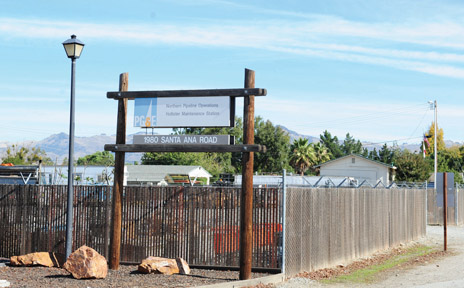PG
&
amp;E inspection spurred by San Bruno disaster
Crews found and repaired a
”
potentially hazardous
”
gas leak at the PG
&
amp;E valve station on Santa Ana Road near Fairview during a
survey of transmission lines on Sept. 19, the utility reported last
week.
The local leak, one of four found statewide on main transmission
pipelines, was repaired by tightening the cap or bolt on the line,
a spokesman confirmed this week. The utility released the initial
results of the statewide pipeline checks in the wake of the Sept. 9
San Bruno gas line explosion, which killed eight people and
destroyed dozens of homes.
PG&E inspection spurred by San Bruno disaster
Crews found and repaired a “potentially hazardous” gas leak at the PG&E valve station on Santa Ana Road near Fairview during a survey of transmission lines on Sept. 19, the utility reported last week.
The local leak, one of four found statewide on main transmission pipelines, was repaired by tightening the cap or bolt on the line, a spokesman confirmed this week. The utility released the initial results of the statewide pipeline checks in the wake of the Sept. 9 San Bruno gas line explosion, which killed eight people and destroyed dozens of homes.
“Safety is our top priority, so as soon as we identified any of these Grade 1 leaks, we repaired them,” said spokesman Joe Molica. Grade 1 leaks “require immediate action, so we addressed the leaks that had the potential to impact public safety.”
The transmission line in question was constructed in 2005 and had been surveyed on Sept. 1, just 18 days before it was re-checked and discovered to have the leak.
The leak “had nothing to do with the pipeline itself,” Molica said. Rather, “it was leaking through the cap or a bolt on a particular valve within our fenced facility. We reported all of these in the interest of transparency.”
Prompted by concern that the San Bruno disaster could repeat itself elsewhere in the state’s thousands of miles of gas pipelines, PG&E did what it called an “accelerated survey” of its gas transmission system, using aerial laser detection technology as well as traditional ground patrols. The utility began by checking pipelines in more populated areas, discovering the four leaks on its main transmission lines along with 34 on distribution lines at other facilities. The entire survey of 4,000 miles of pipelines is expected to be complete by mid-December.
Transmission lines, such as the one found to be leaking in Hollister, move gas to regulator stations which then pipe the gas to individual homes and businesses through smaller distribution lines. These lines range in size from four to 42 inches, though Molica did not know the size of the line that was repaired locally. He did say that the leak apparently occurred when a bolt attaching the top cap to a valve had loosened, perhaps through “normal daily expansion and contraction.”
He said all lines within San Benito County have been inspected and that annual or biannual leak surveys are conducted throughout the distribution system. PG&E also does quarterly aerial or foot patrols to check for leaks.
“This was an additional leak survey we did in the wake of the San Bruno tragedy,” Molica said, noting that lines were checked from Bakersfield to Eureka and eastward to the Sierra.
When a Grade 1 leak is discovered, the employee or contractor who finds it must remain at the location “to ensure public safety until a crew arrives to take corrective action,” according to PG&E’s report to the Public Utilities Commission.
“In the wake of the tragic San Bruno accident, and in close consultation with regulators, PG&E is working intensely to re-examine our transmission pipeline and operational practices to meet our commitment to safe, reliable service,” Kirk Johnson, PG&E’s vice president of gas engineering, said in a press release. “(The Oct. 25 report) shows how much progress we have made in a short period of time, but also points to the significant work still ahead of us.”
Meanwhile, PG&E is continuing an engineering assessment of a gas pipeline that crosses the San Andreas Fault outside of San Juan Bautista between Hwy. 156 and Crazy Horse Road because it may be susceptible to rupture during earthquakes, landslides or through soil erosion.
“We’re doing an engineering analysis analyzing the possible relocation of six miles of pipe to replace two smaller segments of pipe,” Molica said.
The utility company, which has nearly 200 miles of pipeline running through San Benito County, reported that the section near San Juan is on its list of 100 long-range pipeline repairs.
According to a PG&E report, the utility is defining the scope of the project and whether it is necessary.










